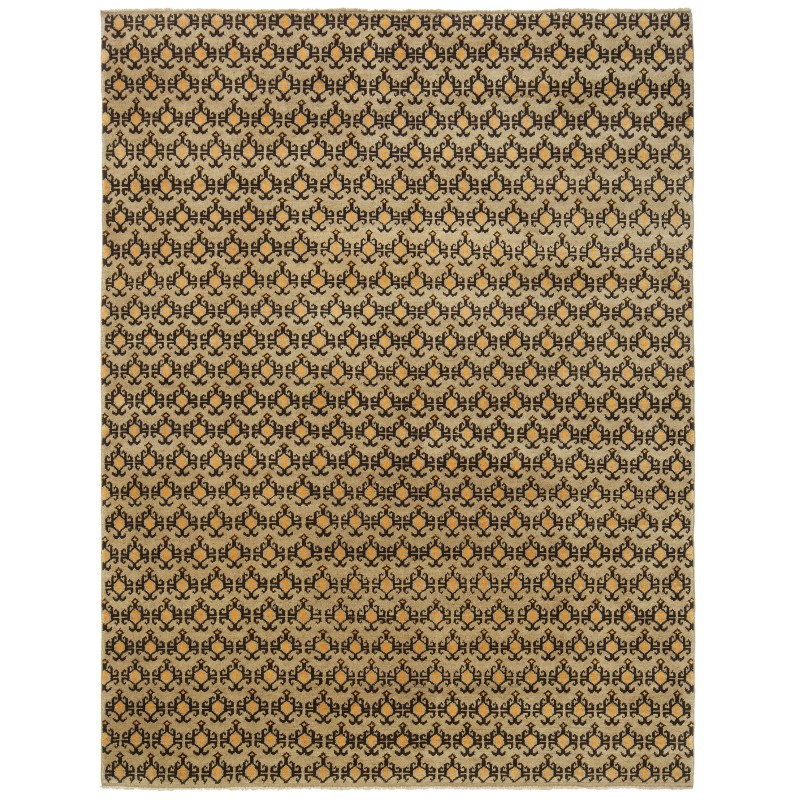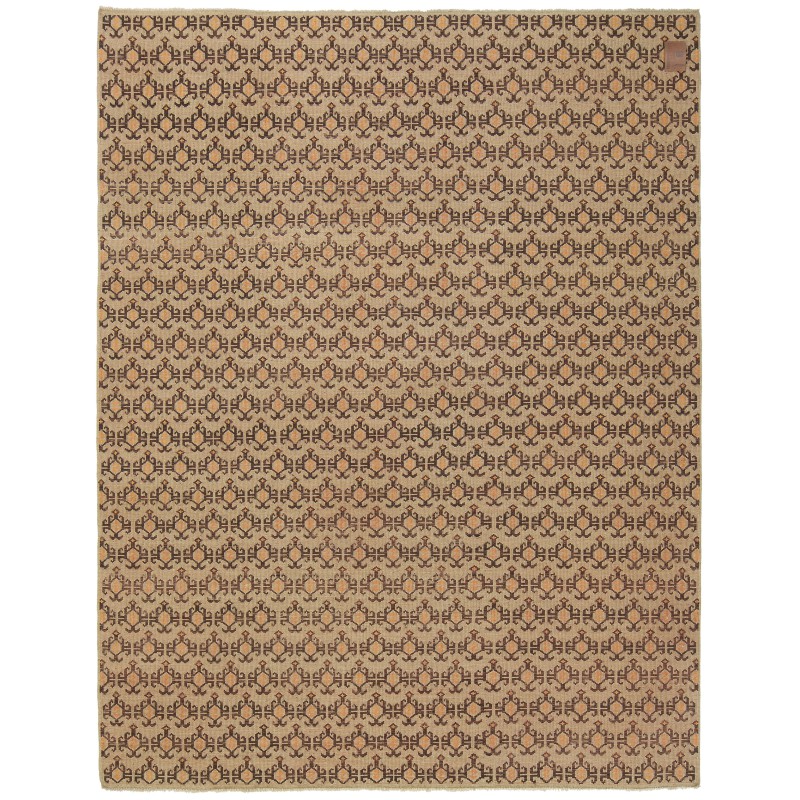



アラエディン・モスクの雲絨毯 The Alaeddin Mosque Clouds Carpet
527,000円
税込み: 527,000円
- Stock: In Stock
- Model: C50346
- サイズ: 228cm x 178cm
- SKU: ART346
この絨毯の情報は、『オリエント・スターズ・コレクション、アナトリアの部族の絨毯1050-1750』(マイケル・フランセス、ハリ・パブリケーションズ株式会社、2021年、図27)から得られています。この13世紀の絨毯はおそらくアナトリアの中部、コンヤ地方のもので、1200年から1300年頃(西暦1290年から1420年頃)の作品です。現在はイスタンブールのトルコ・イスラム美術館で展示されています。セルジューク朝時代はアナトリアの美術と建築の最高峰の時期の一つを示しており、この時代のトルコ結びの絨毯の発見には非常に興奮が起こりました。1905年にフレドリック・ロバート・マーティン(1868-1933)がコンヤのアラエッディン・モスクから7つの絨毯を発見しました。アラエッディン・モスクは12世紀中盤から13世紀中盤にかけて段階的に建設された、スルタン国家の中心地で最も重要なモスクです。これらの絨毯は一般的に「セルジューク」または「アーリーコンヤ」と呼ばれています(ただし、後のコンヤに帰属される絨毯とは関連性がありません)。これらの絨毯は早期のアナトリア絨毯の中で最も重要なグループと見なされるようになりました。その模様は建築物に反映されず、セルジューク朝の芸術を代表するものではありません。おそらくこの時期に中央アナトリアに住んでいた遊牧民族または半遊牧民族のトルクメン族の作品であると考えられます。したがって、「セルジューク朝時代」というラベルがより正確です。4つは大きながらも不完全な状態であり、他の3つは断片的です。これらは1911年にイスタンブールのエブカフ博物館に移され、その後トルコ・イスラム美術館に移されました。
1908年に3つの絨毯をカラーで出版した際、マーティンは次のように書きました。「トルコで最も美しく、最も古いモスクの一つであるアラ・アルディン(アラエッディン)のモスクには、1220年に完成した4つの絨毯と2つの断片があります。このモスクの床には数百点に及ぶ他の絨毯が敷かれていますが、これらは他とは異なる種類であり、同じ時代のものです。地面は非常にシンプルなパターンで飾られています。これらの絨毯の特徴であるボーダーは、クーフィック装飾文字で構成されており、その壮麗な形と大きさから他の絨毯で知られるそのような文字とは全く異なります。明らかにカリフ制度の開始時に使用された壮麗なクーフィック文字の系統のものです。当社のデザイナーはこの絨毯のために柔らかな色合いを選びました。
The source of carpet comes from the book Orient Stars Collection, Anatolian Tribal Rugs 1050-1750, Michael Franses, Hali Publications Ltd, 2021 fig.27. This 13th-century carpet is from probably the Konya region, central Anatolia, circa 1200-1300 (C 1290-1420). It is exhibited at the Museum of Turkish and Islamic Arts, Istanbul. The Seljuk period marks one of the highest points in art and architecture in carpets Anatolia. It is therefore not surprising that tremendous excitement was caused by the discovery of two groups of Turkish knotted-pile carpets from this era. In 1905 seven examples were found by Fredrik Robert Martin (1868-1933) in the Ala’eddin Mosque in Konya, the foremost mosque at the heart of the Sultanate, which was constructed in stages between the mid-12th and mid-13th centuries. Generally referred to as the ‘Seljuk’ or ‘Early Konya’ carpets (although they do not relate to any later carpets that are attributed to Konya), these soon came to be considered the most important group of early Anatolian carpets. Their patterns are not reflected in the architecture and do not represent the art of the Seljuk court; they are more likely the work of one of the nomadic or semi-nomadic Turkmen tribes that inhabited central Anatolia at this time. Labeling them ‘Seljuk-period’ would therefore be more accurate. Four are large but incomplete, the other three are fragmented. They were transferred to the Evkaf Museum in Istanbul in 1911, and then to the Museum of Turkish and Islamic Arts.
In 1908, when he published three of them in color, Martin wrote: ‘In Ala-al-din’s ( Ala’eddin ) Mosque in Konya, which was finished in 1220 AD, are four carpets and two fragments that differ from all others which to the number of several hundred covers the floor of this mosque, one of the most beautiful and most ancient in Turkey. Though in many ways differing, they are nevertheless all of the same kind, and from the same period, viz. contemporaneous with the erection of the mosque. Their ground is decorated with a very simple pattern repeated many times. The border of these carpets, which is their characteristic feature, consists of Kufic decorative letters, which by their pompous form and large size are entirely different from all such letters known on other carpets. They are evidently scions of the magnificent Kufic writing that was in use at the commencement of the Caliphate’. Soft colors are chosen by our designers for this rug.
全部で3色使っています。
- Light French Beige 421 (茶 - ザクロの皮 - クルミの殻)
- Dark Brawn 316 (羊そのままの色)
- Fiery Orange 74 (茜)
上の番号は私たちのカラーコードです。()の中は、主な草木染めの材料です。
